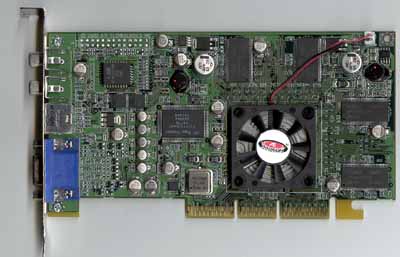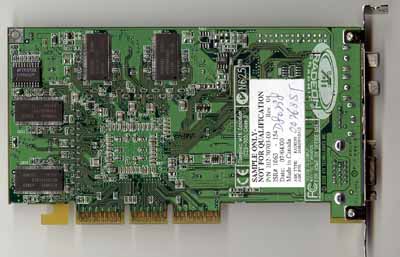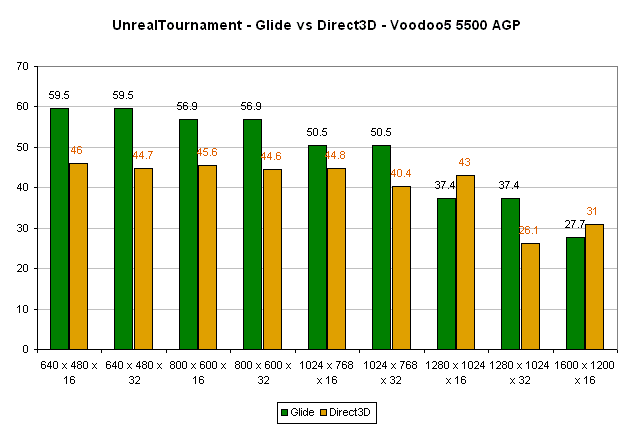
Original Link: https://www.anandtech.com/show/585
Introduction
 A
lot has changed at ATI since its formation in 1985. Long gone are the days when
a complex graphics chip had 10,000 transistors and 3D rendering was a thing
of science fiction. No longer can ATI release a product when it sees fit or
lavish in the quality of their 2D features. No, the world of consumer graphics
cards has become a constantly changing and adopting field of electronics, making
it a very fast paced and dog-eat-dog world.
A
lot has changed at ATI since its formation in 1985. Long gone are the days when
a complex graphics chip had 10,000 transistors and 3D rendering was a thing
of science fiction. No longer can ATI release a product when it sees fit or
lavish in the quality of their 2D features. No, the world of consumer graphics
cards has become a constantly changing and adopting field of electronics, making
it a very fast paced and dog-eat-dog world.
Due to this, any video card company must adapt to the changing times. In many instances unsuccessful, we have seen the fall of great companies that are the foundation of today's technology. Unlike these companies, however, ATI has continued to thrive, at least from a business standpoint. In addition to their adaptation to the changing landscape of the consumer graphics market, ATI has adapted to changes in a vast range of computing fields, from set-top boxes to home entertainment, making it one of the largest image companies in the world.
With all the success that ATI has encountered in the past, there have been recent downfalls. Products such as the Rage128 were plagued with not only delayed releases but poor drivers. "High end" products, such as the Rage Furry MAXX, found themselves paired up with much better performing products from the competitors as a result of these delays. This poor track record was enough to keep the power computer user away from ATI, but good relations ensured ATI's success in the OEM market.
The poor driver support and delayed products marked a dramatic change from ATI's initial reputation. Changing from a consumer target to an OEM pleaser was exactly the opposite of what ATI needed to do in order to stay afloat in the competitive field of consumer graphics. Just as the doctor ordered, times seem to be changing for ATI again, this time for the better.
ATI's new approach to the 3D graphics card market was initially displayed with the Rage6C core. The announcement of this core in April at WINHEC was customary of the typical ATI announcement with many promises made. Once again as a product of ATI's poor track record, people assumed that a card based on the Rage6C would be at least 3 or 4 months delayed from the expected release date of August, emerging well in the turf of NVIDIA's upcoming NV20. However, with cards shipping to retail locations by the time you read this and ATI preaching a 6 month new product cycle, even John Carmack is talking about ATI's Radeon card; and when Carmack is talking, the whole industry is talking.
The Chip
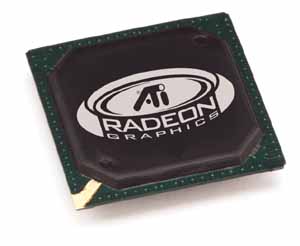 The
Rage6C core is unlike any other core that ATI has designed. The core is not
a refresh of the aging Rage128 core but a new product completely. Not much has
changed since the Radeon's announcement in April, but let's review what we already
know and see what one item has changed.
The
Rage6C core is unlike any other core that ATI has designed. The core is not
a refresh of the aging Rage128 core but a new product completely. Not much has
changed since the Radeon's announcement in April, but let's review what we already
know and see what one item has changed.
For the most part, what ATI said they would deliver with a Radeon card has found its way into the shipping cards. As suspected, the architecture of the chip is .18 micron with two rendering pipelines with three texture units per pipeline for a total output of 6 texels per clock. Having 2 less texels per clock of the GeForce 2 GTS, with its four pipelines and 2 textures per pipe, in theory the Radeon is crippled by these pipelines.
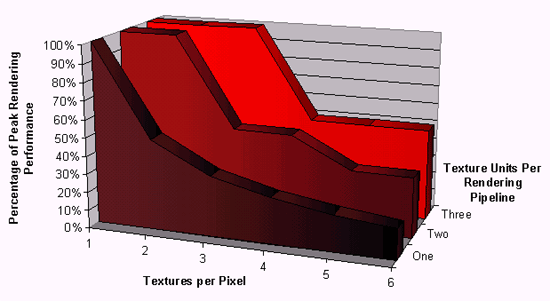
The reason for this is that dual texture games, such as Quake III Arena, will actually end up not using one of the textures in the Radeon's three texture pipeline. The GeForce 2 GTS's pipeline does not encounter this problem in dual texture games since each pipeline is able to use both texture units for rendering.
The tables become turned, however, when a scene being rendered has three or more textures per pixel. In this case, the Radeon's pipeline architecture is capable of using each texture unit in rendering, resulting in one pass per pixel rendered. The GeForce 2 GTS, on the other hand, relies on two of its pipelines to render a single pixel in a three textured game, with one pipeline rendering two textures and a second one rendering the third, leaving the second texture in the second pipeline wasted. Although few games use 3 textures per pixel, ATI is betting on this to become the embraced standard.
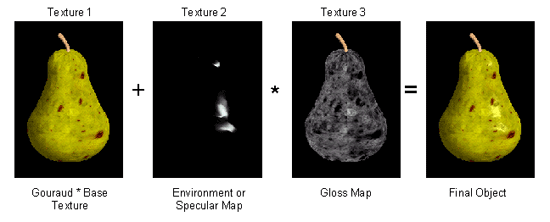
The second part to ATI's decision to use a three texture unit pipeline comes from the fact that texels simply do not add speed due to memory bandwidth limitations. This can be seen in the GeForce 2 GTS: while the GPU is capable of pushing out 1.6 gigatexels per second, this fill rate is never seen due to the extensive memory bandwidth limitations encountered.
More of the Chip, part I
With a transistor count of 30 million, 5 million more than the GeForce 2 GTS, one has to wonder what additional features ATI has packed into the core to result in such a large transistor count. Let's take a look at some of the features that the Rage6C core provides.
A large number of those extra transistors go into making what ATI likes to call the Charisma engine, which provides for T&L features. Like the GeForce 2 GTS's T&L solution, the Charisma engine can perform transforming, lighting, and clipping calculations directly on chip, making it equivalent to the GeForce 2 GTS's second generation T&L engine.
In addition to these T&L enhancements, the Charisma engine features T&L capabilities for both vertex skinning and keyframe interpolation, giving it an edge over the GeForce 2 GTS's T&L engine. Both features which ATI claims will provide for significant speed increases in future games, vertex skinning and keyframe interpolation are new to the T&L solution.
Vertex skinning allows for more realistic bending/moving of polygons in games that use skeletal animation so that characters appear to move more realistically than the blocky motion we’re used to seeing in games. Although the improvements seen with vertex skinning are noticeable, a game engine must be designed to take advantage of this enhancement.
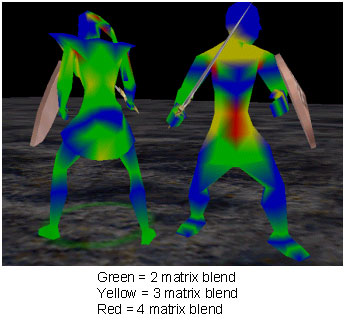
Keyframe interpolation is another feature that has to be implemented by developers before any results will be seen. In this method of acceleration, a game developer may design a starting and stopping frame in a given animation and the Charisma core will take over in between, providing a proper transformation from the first frame to the last.
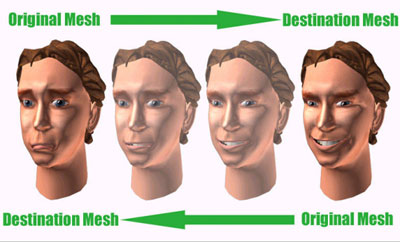
More of the Chip, Part II
In addition to these hardware T&L solutions, the Charisma core actually implements features of the yet to arrive DirectX 8 API. Including support for 3D textures and 4 matrix vertex skinning (used in Microsoft's upcoming Dragon Siege) ensures that the Radeon will be able to handle the next generation of games. In addition, environmental bump mapping will be supported by the Radeon. NVIDIA's current generation of cards do not support this bump mapping method, however Matrox has been using it since the G400.

With all these features, developers seem to agree: the Radeon will be the most feature rich GPU on the market today.
The Radeon has the best feature set available, with several advantages over GeForce... On paper, it is better than GeForce in almost every way except that it is limited to a maximum of two pixels per clock while GeForce can do four. This comes into play when the pixels don't do as much memory access, for example when just drawing shadow planes to the depth/stencil buffer, or when drawing in roughly front to back order and many of the later pixels depth fail, avoiding the color buffer writes.
Depending on the application and algorithm, this can be anywhere from basically no benefit when doing 32 bit blended multi-pass, dual texture rendering to nearly double the performance for 16 bit rendering with compressed textures. In any case, a similarly clocked GeForce(2) should somewhat outperform a Radeon on today's games when fill rate limited. Future games that do a significant number of rendering passes on the entire world may go back in ATI's favor if they can use the third texture unit, but I doubt it will be all that common.
The real issue is how quickly ATI can deliver fully clocked production boards, bring up stable drivers, and wring all the performance out of the hardware. This is a very different beast than the Rage128. I would definitely recommend waiting on some consumer reviews to check for teething problems before upgrading to a Radeon, but if things go well, ATI may give nvidia a serious run for their money this year.
- John Carmack, .plan update 5/17/00
In addition to the features of the Charisma core, ATI also added integrated TMDS support in the chip, making DVI-output an easy addition. This feature seems targeted mostly to ATI's strong OEM market, as ATI could not predict if any DVI models will make it to the retail stores, but one should be able to find these cards as special OEM box purchases online.
Despite the addition of some additional features that were not present at the product launch, one card spec actually took a turn for the worse. At WINHEC, ATI told us of a card that would have an impressive memory and core speed of 200 MHz. Well, as speed specs often do, ATI decreased the core and memory clock specs for the shipping Radeon. Due to what seems to be the unavailability of 5 ns DDR SDRAM, ATI was forced to take 5.5 Ns DDR SDRAM, putting the memory clock speed at 183 MHz DDR (366 MHz effective). The core speed, either due to less than expected yields or just ease, is also shipping at the 183 MHz mark. As we will see in the benchmarking section, pushing up the core really does not result in any performance increase due to extensive memory bandwidth limitations.
The 183 MHz core and memory speeds provide the Radeon with a raw fill rate of about 1.1 gigatexels per second, and 366 megapixels per second. With a drop of about 100 megatexels per second and 34 megapixels per second from the announced solution, the shipping Radeon cards are also 500 megatexels and 434 megapixels slower than the GeForce 2 GTS.
ATI is betting that this will not matter, once again due to memory bandwidth limitations. ATI claims that even if you’re using 200MHz DDR SDRAM (effectively 400MHz), you’re limited to a 300 megapixels per second fill rate at 32-bit color with a 32-bit Z-Buffer, so adding more pixel pipelines would not’t help them, which is why they focused on having three texture units per pipeline. To see if this is the truth or not, we will have to turn to the benchmarks, which are given later in this review.
HyperZ
When we took a look at PowerVR's new chip solution, the Kyro, it became clear that a tile based rendering technique had some major advantages over the conventional rendering technique. By substantially decreasing the amount of data that had to pass over the relatively slow memory bus, the tile based rendering solution seemed like a good idea.
ATI seems to have agreed as well. Taking some of the techniques involved in tile based rendering, ATI created their HyperZ technology. HyperZ enables various forms of compression of the data going to the Z-buffer and performs an early culling of polygons so that objects that aren’t visible to the viewer aren’t rendered. By doing so, ATI claims that they can boost the effective memory bandwidth by about 20%.
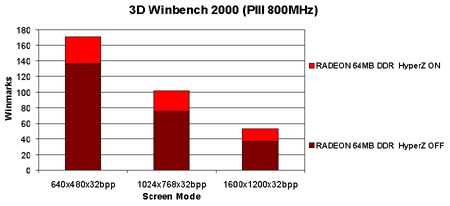
Now that we know a bit behind the chip that powers ATI's new Radeon graphics card, let's take a look at how the chip is used.
The Card
The Radeon 64MB DDR and Radeon 32MB DDR, which will be available in retail locations by the time you are reading this, are the first installments of the Rage6C core. Look for a 32MB SDR version in the near future, however these cards are not shipping yet. We tested a 64MB DDR retail card.
Based on a .18 micron architecture, the core of the Radeon runs relatively cool. In fact, the card dissipates about 8W max power, about 4W more than that of the extremely cool GeForce 2 MX and 8W less than the hot running GeForce 256 chip. As a result of this cool running temperature, the heatsink and fan combination on the Radeon is rather small. We suspect that ATI did not need to even add the fan and/or heatsink but did so to improve the visual characteristics of the card: when one sees a card with out any form of active cooling, one usually assumes that it is a lower performing card.
With all the video input and output features of the card, there was no room to place a DVI connector on the board to take advantage of the core's built-in TMDS. We suspect that all DVI cards will be sold through OEM channels and will lack any of the VIVO features seen on this test card here. It will most likely be possible to pick up one of these cards in white-box OEM only version, but don't look for it on the retail shelves.
No other feature of the Radeon 64MB PCB board was noteworthy. Similar to many cards we have seen in recent months, the Radeon reference design has a plethora of capacitors and inductors to aid in power regulation.
Video Options
In addition to the powerful Charisma engine, some of the Rage6C's 30 million transistors go to the hardware IDCT and HDTV support. IDCT, inverse discrete cosine transform, is one aspect of software DVD playback that is extremely hardware intensive. By including hardware IDCT support in the core, ATI has been able to accelerate DVD playback performance significantly compared to other pure software based DVD decoding methods. This one aspect of ATI cards have kept some users sticking with their ATI cards through the bad and the good.
HDTV support is another aspect of the core that ATI seems excited about. By having full HDTV support in the core, the possibilities are limitless for what ATI can do with an All in Wonder based Radeon card. Rather than spending a few thousand of dollars to get an HDTV ready TV, ATI is suggesting that you experiment in some HDTV viewing right from your computer monitor. In addition, this HDTV signal could then, in theory, be passed directly to the card's S-Video output, making it possible to view HDTV signals on a normal TV without a conversion box. Keep in mind, however, that you are still limited by the S-Video resolution, meaning that it still will not look as good as a true HDTV signal.
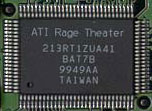 As mentioned before, the Radeon's video input and output are controlled by the
Rage Theater chip. This is the same chip that was found on the Rage Fury Pro
(Rage 128 Pro). Below is an except from that review.
As mentioned before, the Radeon's video input and output are controlled by the
Rage Theater chip. This is the same chip that was found on the Rage Fury Pro
(Rage 128 Pro). Below is an except from that review.
The card itself supports capturing in raw (uncompressed) YUV9, ATI VCR 1.0, ATI VCR 2.0, MPEG-1, or MPEG-2 video formats. The capture format that should be used varies depending on the intended use of the video and how much CPU power is available. Everyone can, of course, play raw uncompressed video, but the file sizes are simply unreasonable. In all cases, a hard drive capable of keeping up with the data being written is necessary. Raw video does require quite a bit of sustained hard drive performance.
The VCR 1.0 and 2.0 formats are proprietary ATI formats, but may be playable on other systems using AVI extensions. However, it is difficult (ie not possible with most software, including ATI's) to edit MPEG-1 or 2 video streams, making the VCR formats still very useful. According to ATI, this may change as MPEG formats increase in popularity. For distribution purposes, the final edited video can be saved in either of the two MPEG formats.
The best format for distributing video is most likely MPEG-1 since it is widely accepted and almost everyone has the appropriate CODEC for playback (it is now included in Microsoft's Windows Media Player). MPEG-1 provides approximately VHS level quality and is used in Video-CD's. The compression level is better than the ATI VCR formats and is more universally accepted. MPEG-2 is gaining popularity and will play using just about any software DVD player since DVD is just MPEG-2 video. Compression and quality levels are higher than that of MPEG-1, but of course require the most CPU power. Of course, the available formats are heavily dependent on what CPU is in use.
The Drivers
In the past, drivers have always been a major road block in the way of ATI's path to success. This was seen with the numerous driver problem associated with both the Rage128 and the Rage Furry MAXX cards. With this in mind, it is natural to wonder about the drivers shipping with the Radeon.
Fortunate in some respects and unfortunate in others, ATI was able to use the Rage128 drivers as the foundation for the Radeon's driver set. Although ATI argues that this puts them at an advantage because the drivers they are using for the Radeon have had about a year and a half to mature, the opposite argument can be made that they still have not gotten it right in all that time so it is best to start again.
What did we find? The Radeon's drivers may be better than those released with the original Rage128 and the Rage Furry MAXX, however they are far from the reliability and quality scale we have come to find in ATI's closest competitors.
The first instance of this was seen with ATI's install program, which essentially copies over 20 files to the Window's directory to get the card to function correctly. In comparison, NVIDIA's divers have always written a very small number of system files, making uninstallation painless.
Once the drivers were installed, we saw the typical set of ATI's VIVO programs, including ATI DVD and ATI Video. Some of the features of these programs have changed a bit from previous releases, but the changes are subtle, as shown below.
The driver screens are very similar to those of previous versions, with a few extra buttons added that take advantage of the Radeon's advanced features. This can be seen with the FSAA and texture compression buttons shown below.
On the FSAA note, the enable/disable button in the drivers enables 4x FSAA, the only FSAA mode that the Radeon supports, but more on that later.
As mentioned before, the Radeon's driver set still leaves much to be desired. Still present from the Rage128 days is the texture shimmering when in 16-bit color. In addition, the card still performs poorly at 16-bit color, once again a result of the poor driver sets. While this makes running in 32-bit color more attractive (as shown in the benchmark sections), it does limit the options one can play at.
The Drivers (cont)
The shipping drivers do have a slight alpha-blending problem when at 16-bit color, causing lines to be displayed on the image when running with timedemo on. Not as noticeable, if at all, with timedemo off, ATI knows about this problem and a driver update is should be available soon that fixes it. As always, be sure to get the most recent driver from ATI's website before you go playing any games.
 |
|
16-bit
color |
 |
|
32-bit color |
Rage128 drivers have a history of not getting along with VIA chipsets, and unfortunately this seems to be the case with the Radeon as well. In the past we have seen some cards not even work on VIA-based systems, such as the Rage Furry MAXX. Luckily, the problems associated with the Radeon in Athlon systems are not as bad as in the past, but they may cause headaches for many.
The first problem with the Radeon's drivers on VIA-based systems is that the install program actually replaces any version of the VIA GART found on the system with version 3.30, which is packaged with the drivers. Although this may end up helping some with older GART drivers, it will hurt power users in the long term as the install program replaces any GART driver on the system with the packaged version, even if the drivers on the system are newer than those in the video card install program. For example, in our Athlon KX133 test system, the older GART version actually prevented us from getting into Windows, forcing us to boot in safe mode to restore the new GART drivers. The newest version of GART, version 4.03, is available from VIA's website.
This flaw will result in decreased card performance, as the older GART versions almost never have the same speed as the new ones. In addition, some systems may even be inoperable with the older GART drivers, forcing the user to boot in safe mode to replace ATI's GART driver with the previous one. Luckily, these problems only arise under the normal install. The custom install option does bring up a check box for "upgrading" the GART drivers which can be unchecked. We highly suggest that everyone with a VIA chipset in their system uncheck this option and gets the newest GART version from VIA's website.
The second issue arose when we tried to use the Radeon in a VIA system with AGP 4x enabled. With this setting turned on in the BIOS, the card would not run Quake III Arena at all, crashing at the ID logo. Although this problem does prevent AGP 4x mode from working, the card worked fine when AGP 4x was disabled. We have shown time and time again that AGP 4x really offers no performance increase over AGP 2x mode, where the card works flawlessly. So, while one may not loose performance over the lack of AGP 4x support in VIA systems, some will suffer headaches due to this issue. ATI notified us that this problem only plagues VIA chipsets with the CD revision of the North Bridge. Newer KX133 motherboards, with revision CE, as well as all KT133 motherboards worked fine with AGP 4x enabled in our testing. The only Apollo Pro 133A chipsets available in the lab at the time of publication were those based on the CE north bridge. However, those motherboards would not work in AGP 4X mode, despite the newer CE revision. Dropping back to AGP 2X mode allowed the system to function as expected.
 |
|
North
bridge revision CD
|
 |
|
North
bridge revision CE
|
The Drivers- Pictures
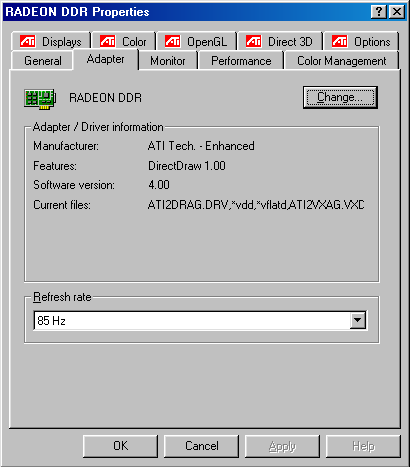
The information screen shows that we are indeed using a Radeon.

The color calibration screen is virtually unchanged from previous drivers.
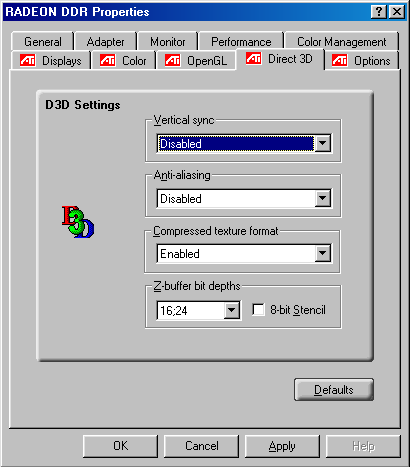
D3D settings offered a few features not previous in older cards.
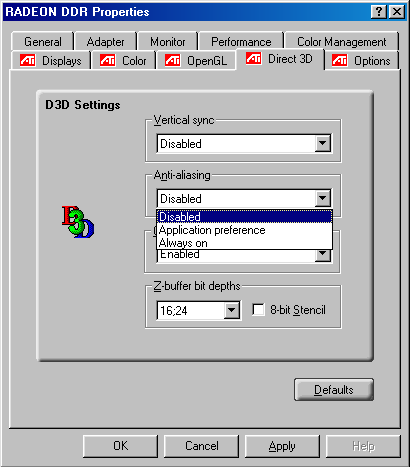
There are only 3 D3D FSAA settings. The "Application preference" option
only does FSAA if the application requests it.
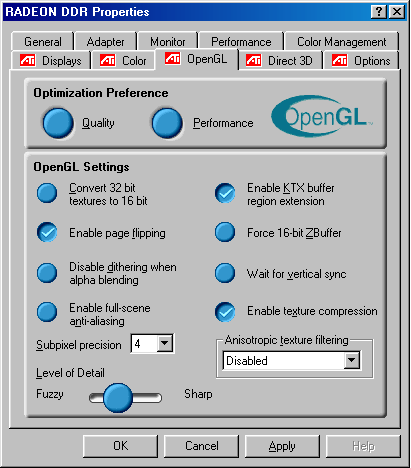
The OpenGL driver screen offered a few tweaking options.
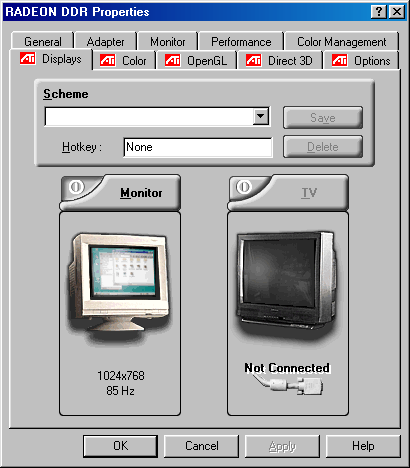
Display screen allows for other modes of view.

The Options screen really only contained driver information.
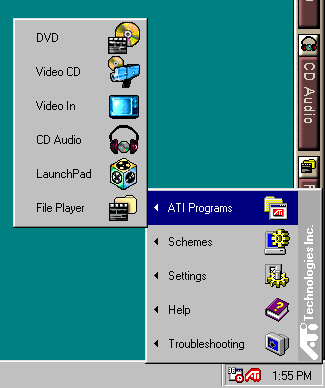
The taskbar utility did provide easy access to some of the Radeon's features.

The LaunchPad program allows for easy use of the internal programs.
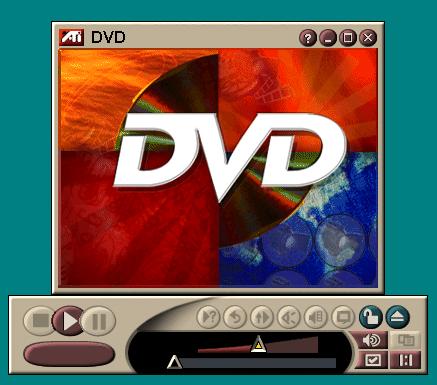
The DVD player to put that excellent DVD playback to use.
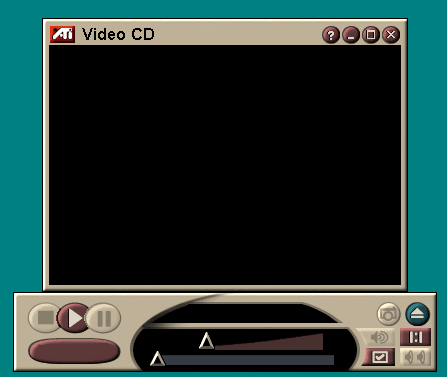
Video CD allows for viewing of just those: video CDs.
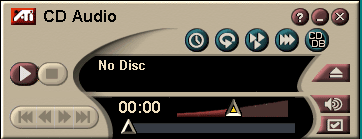
A CD Audio player is packaged as well.
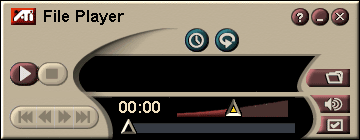
File Player allows for playback of common types of movie files.
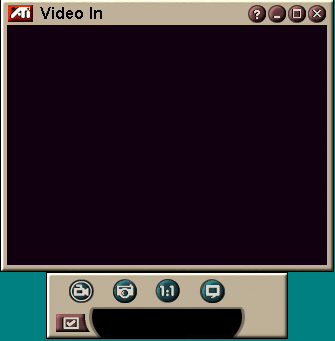
Video-in takes advantage of the cards VIVO features.
The Test
For the testing, we used the same systems as were used for the GeForce 2 GTS review, with updated drivers. In the case of the Radeon, we tested with the shipping drivers with V-sync disabled as well as "Convert 32-bit textures to 16-bit" turned off. Below is the testing section from the GeForce 2 GTS review.
We chose three systems to measure the performance of these video cards. Remember that this is a comparison of the performance of video cards, not of CPUs or motherboard platforms.
For our High End testing platform, we picked an Athlon 750 running on a KX133 motherboard. The Athlon 750 is fast enough that it won’t be a limiting factor in the benchmarks and should also provide a good estimate of how all of the cards compared would perform on a 600 – 800MHz Athlon or Pentium III system (it will at least tell you which card would be faster).
For our Low End testing platform we picked a Pentium III 550E running on a BX motherboard. Although this isn’t a very “low-end” processor, it is fast enough to see a performance difference between video cards without the processor stepping in as a huge limitation. If we used something like a Celeron 466, the performance of virtually all the cards would be virtually identical at the lower resolutions because the CPU and FSB/memory buses are limiting factors. Once again, this is a test of graphics cards not of CPU/platform performance.
For our FSAA testing, we picked a 1GHz Pentium III running on an i820 motherboard with RDRAM. The reason we picked this platform (we are aware that it isn’t widely available) is because it eliminates virtually all bottlenecks that would be present and allows us to illustrate the biggest performance hit enabling FSAA would result in. Slower setups would have lesser performance hits because they have more bottlenecks.
|
Windows 98 SE Test System |
||||||
|
Hardware |
||||||
|
CPU(s) |
Intel Pentium III 1.0EB
|
Intel Pentium III 550E |
AMD Athlon 750
|
|||
| Motherboard(s) |
AOpen
AX6C
|
AOpen AX6BC Pro Gold | AOpen AK72 | |||
| Memory |
128MB
PC800 Samsung RDRAM
|
128MB PC133 Corsair SDRAM |
128MB
PC133 Corsair SDRAM
|
|||
| Hard Drive |
IBM Deskstar DPTA-372050 20.5GB 7200 RPM Ultra ATA 66 |
|||||
| CDROM |
Phillips 48X |
|||||
| Video Card(s) |
3dfx
Voodoo5 5500 AGP 64MB ATI
Radeon 64MB DDR ATI Rage Fury MAXX 64MB Matrox Millennium G400MAX 32MB (would not run on Athlon platform) NVIDIA
GeForce 2 MX 32MB SDR (default clock 175/166) S3 Diamond Viper II 32MB |
|||||
| Ethernet |
Linksys LNE100TX 100Mbit PCI Ethernet Adapter |
|||||
|
Software |
||||||
|
Operating System |
Windows 98 SE |
|||||
| Video Drivers |
|
|||||
|
Benchmarking Applications |
||||||
| Gaming |
GT
Interactive Unreal Tournament 4.04 AnandTech.dem |
|||||
Quake III Arena - Athlon 750

We can already see what the Radeon thinks of 16-bit color. As a result of our graphs being sorted by 16-bit color performance, the Radeon 64MB DDR actually lies below the GeForce 256 SDR on the above graph. One one examines the color depth that ATI is attempting to push, 32-bit color, it is clear that the Radeon excels here. Not only does the card loose less than 2 FPS when going from 16-bit to 32-bit, the card's 32-bit performance is actually the fastest card we have tested, with a FPS rating of 111.3. If the graphs were sorted by 32-bit performance, the Radeon would no longer be sandwiched between the GeForce SDR and the Viper II but would take its spot on top of the graph.

Once again, at 800x600 we find that the Radeon's poor 16-bit performance level keeps it near the bottom of the graph. We can see why ATI is not pushing this card as a 16-bit gaming option, however the card's poor image quality when in 16-bit color should be enough to keep Radeon owners playing at 32-bit color, where its performance really shines. When at 800x600x32, the card performed only .7 FPS than our fastest card at this resolution, the GeForce 2 GTS 64MB. The Radeon's 32-bit color performance places it slightly behind the GeForce 2 GTS but well ahead of the GeForce 256 DDR, making the Radeon a true competitor for the high-end graphics spot, when in 32-bit color that is.

Being represented in the above graph by 16-bit performance once again, the Radeon appears to be a slow card. It is not until one notices the very small performance decrease between 16-bit and 32-bit color does one see why the Radeon can perform so well at 32-bit color. Be it a function of the drivers or the chip's architecture, the Radeon is just not meant to run in 16-bit color.
When at 32-bit color we find that like at 800x600x32, the Radeon falls only very slightly behind the GeForce 2 GTS in terms of speed. Lagging this card by only 1.6 FPS, the Radeon can serve its place as a high-end video card rather well. While the card manages to beat the Voodoo 5 5500 by only a small amount in 16-bit color, the Radeon actually performed 19.6% faster than the 5500 in 32-bit color, a full 12.9 FPS faster.

We have seen 1280x1024 become a more and more playable resolution for many with the arrival of the GeForce 2 GTS. Luckily for gamers out there wanting to run at this resolution, the Radeon makes this resolution even more accessible. While the card may get dominated at 16-bit color, as we have found in previous benchmarks, it actually surpasses the prior king, the GeForce 2 GTS, when in 32-bit color mode.
Running at 51.3 FPS, the Radeon 64MB DDR was able to perform 13.2% better than the GeForce 2 GTS 32MB and 3.8% better than the 64MB GeForce 2 GTS. At 1280x1024x32, the Radeon becomes the new king of the hill.

1600x1200 is still a resolution that many dream of but few run in. At 16-bit color, the Radeon is crippled, as it always is, by the poor performance at this color depth. When cranked up to 32-bit color, we find that the Radeon actually surpasses the GeForce 2 GTS. The card was able to perform 11.6% faster than the GeForce 2 GTS 64MB and 21.8% faster than the 32MB GeForce 2 GTS, proving that the Radeon truly excels at high resolutions and colors.
Quake III Arena - Pentium III 550E

To demonstrate how the card would perform in a somewhat lower speed processor, we ran the Quake III Arena built in demo001 in a Pentium III 550E.
Similar to what we saw in the Athlon 750 system, the Radeon really does not show any difference when switching from 16-bit to 32-bit color, meaning that essentially all Radeon owners will want to run the cards in 32-bit color mode due to the lack of a performance drop. Our graphs, which are once again sorted by 16-bit color as we have always done them, places the Radeon near the bottom of the performance scale. When examining the 32-bit color performance of the card, we find that it is slightly below that of a GeForce 256, most likely a result of immature drivers.

We again see that the 16-bit performance of the card is weak, at best. By pushing 32-bit color gameplay, ATI has essentially changed their card's performance from that of a GeForce SDR to that of a GeForce DDR. It seems that performance is still somewhat lower compared to what we saw in the Athlon 750 system, as at this resolution in the Athlon 750, the Radeon was only slightly slower than the GeForce 2 GTS when in 32-bit color. At this lower end processor system, the Radeon essentially matched the speed of the 64MB GeForce 256 DDR.

At 1024x768x16, we see that the Radeon does not perform horribly, coming in right behind the GeForce 256 DDR 64 MB, however it does not live up to its potential until it is pushed into 32-bit color mode. When at 1024x768x32, we see the same results on this Pentium III 550E system as we saw in the Athlon 750 system at 800x600x32: that the Radeon is only slightly slower than the GeForce 2 GTS. When at this resolution, the Radeon 64MB DDR was able to perform only about 3.5 FPS slower than the top performing GeForce 2 GTS based cards. Once again, this shows that the Radeon is ready to take on some tough competition, as long as it is at 32-bit color.
Quake III Arena - Pentium III 550E (cont)

Essentially limited again by our 16-bit performance graphs, the Radeon actually takes the top spot when at 1280x1024x32. Performing 2 FPS (4%) faster than the previous speed king, the GeForce 2 GTS 64MB when in 32-bit color, the Radeon proves once again that it is out for blood. Too bad its poor 16-bit color performance will keep some away.

The Radeon's 16-bit color performance is actually able to beat the GeForce 256 when at 1600x1200x16, but the poor rendering quality as well as the small performance drop will keep many from even trying the Radeon at 16-bit color.
More importantly, the Radeon proves to be the fastest card yet when at 1600x1200x32. Similarly to what was found on the higher performing Athlon 750 system, the Radeon 64MB DDR put out 36.2 FPS. Still unplayable to many gamers, this speed is 11.7% faster than the GeForce 2 GTS 64MB.
From our GeForce 2 GTS review
Any attempt to substantially push a video card to its limits using the built in Quake III Arena demos is almost impossible. The level is not only low on the texture front, it also does not contain as many rooms as other levels. Resolutions and colors where the demo plays flawlessly are often too high to play the game in full with.
In order to fully test how memory bandwidth and RAM size affects video card performance, a separate and more stressful benchmark is needed. For the purposes of this test, we turned to Anthony "Reverend" Tan's Quaver benchmarking demo. It was a well known fact that some levels of Quake III Arena push video cards harder than others. The most notorious of these levels is the Q3DM9 map, with a reported 30 plus megabytes of textures.
Quake III Arena quaver.dm3 - Athlon 750

Cards, on the whole, usually do not have a problem with Quaver when at low resolutions. The demo initially stressed cards very heavily when at higher resolutions and colors due to the large texture sizes which caused AGP texturing. At 640x480x16 as well as 32, we find that the Radeon is somewhat lacking in performance. This is most likely a result of poor drivers.

At 800x600x32 we see that cards start dropping in performance significantly. Luckily, the implementation of OpenGL (S3TC) compression enables the GeForce cards to not react to the large textures Fortunately for ATI, the Radeon has built-in OpenGL compression which is compatible with NVIDIA's S3TC compression method. As a result of this, the Radeon does not react when the large amount of information is being passed to it, as the card's performance is only somewhat slower than the GeForce 2 GTS.

Once again we see that non S3TC compatible cards drop significantly in performance when at the high resolutions and color depths. The Radeon is able to perform with the best of them, falling well behind the GeForce 2 GTS cards when in 16-bit color, but coming very close in 32-bit mode.
Quake III Arena quaver.dm3 - Athlon 750 (cont)

Once again, at 1280x1024x32, the Radeon finds itself on turf that it loves. It may seem low performing due to the poor 16-bit performance of the card, but hidden under that 16-bit bar lies the true calling of the Radeon: 32-bit. With 1280x1024x32 becoming more playable with the new generation of cards, the Radeon became the fastest 32-bit card in Quaver at 1280x1024 with an impressive 49.2 FPS. This makes it 2.9%, or 1.4 FPS faster than the previous champ: the GeForce 2 GTS 64MB.

At 16-bit color, the Radeon is not slow, but at 32-bit, the card flies. Beating the GeForce 2 GTS 64MB by 3.1 FPS, the Radeon showed a 9.6% improvement over the GeForce 2 GTS 64MB.
Quake III Arena quaver.dm3 - Pentium III 550E

Once again representing our lower-end systems we have the Pentium III 550E running Quaver. The cards are able to handle the complex Quaver demo without too much trouble when at 640x480. One thing to note is how poorly previous ATI cards performed when in 32-bit color. My, how times have changed

The Radeon, with its OpenGL texture compression (S3TC compatible), is not able to keep up as well as when in higher resolutions, as the card performs around the level of a GeForce DDR. The card is easily toppled in 16-bit color, as we have found in previous tests.

The Radeon beings to shine a bit when at 1024x768x32, however it does not do as well comparatively as when in the Athlon system. The Radeon performs slightly slower than the GeForce 2 GTS when in 32-bit color but lags once again in 16-bit color.
Quake III Arena quaver.dm3 - Pentium III 550E (cont)

The Radeon is able to keep up with its competitor when at 16-bit color at 1280x1024, however the card does not nearly reach the same margin of performance as the GeForce 2 GTS based cards. Tables turn, as usual, when the game is running in 32-bit color, with the Radeon performing 9.7% faster than the GeForce 2 GTS, a full 4.2 FPS faster. This performance margin is dropped, however, when compared with the GeForce 2 GTS 64MB, where the Radeon only performed 2.5% faster (1.2 FPS).

Although few play at 1600x1200x32, the Radeon really shows its stuff here. 16-bit color performance in this mode is weak, once again, but 32-bit performance is as strong as expected. 34.9 FPS makes the Radeon the fastest card at 1600x1200x32.
Quake III Arena NV15
Produced by NVIDIA upon the launch of the GeForce 2 GTS, NV15.dm3 served as a Quake III Arena demo that pushed video card's to the limit. Built to put a huge strain on a specific card's ability to draw the largest number of polygons as possible, NVIDIA actually made the level have significant overdraw. By rendering not only each wall that the demo player looks at but also every room behind this wall, the graphic's card is forced to draw many times the number of polygons that it normally draws. When in wire-frame mode, with the wall textures transparent, it seems as if the rooms just keep going and going.
The GeForce 2 GTS was able to perform well in this demo due to the second generation T&L engine on this card. To test the Radeon's T&L ability, we ran the GeForce 2 GTS, the GeForce DDR and the Voodoo5 5500 against the Radeon DDR 64MB. Although T&L does not play an important role in current games, both ATI and NVIDIA are betting that it does in the future. Let's see what we found out about the Radeon's T&L in this custom NVIDIA level.
Quake III Arena NV15.dm3 - Pentium III 1GHz

At 640x480 one can really see the difference that T&L makes. The non-T&L video card tested, the Voodoo5 5500, shows a drastic performance drop compared to the other cards.

We see that at 800x600, the Radeon's Charisma engine is able to keep up with NVIDIA's T&L engine. Note that performance is not poor at 16-bit color, as we saw in the past.

When at 1024x768x16, the Radeon performs just behind the GeForce 2 GTS's T&L. At 32-bit color, the Radeon's T&L engine actually outperforms the GeForce 2 GTS's engine, even in NVIDIA's own level.
Quake III Arena NV15.dm3 - Pentium III 1GHz (cont)

As we have seen in the past, 16-bit color performance is severely limited, but the card performed extremely well in 32-bit color. Going 16.9% (4.1 FPS) faster than the GeForce 2 GTS, the Radeon shows what some of those 30 million transistors do, giving it an edge in NVIDIA's own level.

Falling in 16-bit color performance once again to the GeForce 2 GTS, the Radeon surpasses the same card by a large margin when at 32-bit color. With such high colors and resolutions, the T&L engine is really being stressed, as is the rest of the card. The Radeon performed 20% (3.8) FPS faster than the GeForce 2 GTS, even in NVIDIA's own level.
Unreal Tournament Performance
From our GeForce 2 GTS review
While Unreal Tournament does offer native support for Glide, we refrained from testing the Voodoo5 in Glide. Why? Have a look at the performance numbers taken from a Voodoo5 running Unreal Tournament in Glide vs Direct3D:
The first thing to notice is that there is no performance difference between 16 and 32-bit color when running in Glide, this is most likely due to Unreal Torunament not allowing 32-bit color/textures when running in Glide, especially since the scores were perfectly identical between 16 and 32-bit color modes.
Secondly, as the resolution increases, the performance of the Voodoo5 running in Glide mode drops below that of Direct3D indicating that it wasn't meant to be run at such high resolutions, which is one possible explanation.
Regardless, the Unreal Torunament scores were already difficult to explain because of the number of limitations acting on the Unreal Torunament engine (look back at our reasons that Unreal Torunament isn't a good benchmark) and adding Glide scores wouldn't do much good other than adding two more lines to the graphs.
Unreal Tournament - Athlon 750

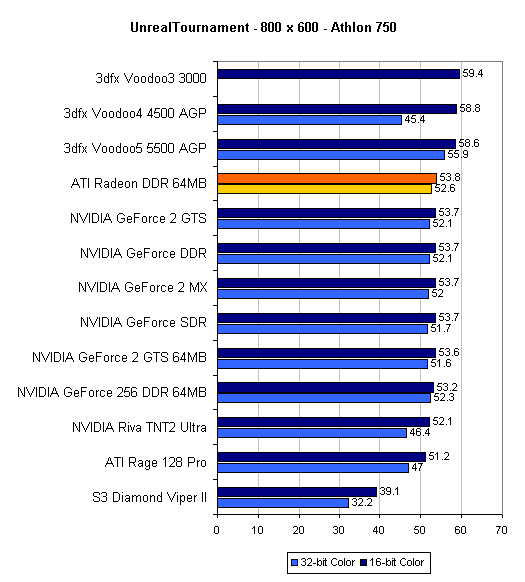

Unreal Tournament really has a problem telling cards apart. Most likely a product of its aging engine, our benchmark showed only slight performance differences when in lower resolutions. The GeForce 2 GTS, with its impressive fill rate, beats the Radeon 64MB DDR in many instances in both 16-bit and 32-bit color. In fact, as seen in the past, the Radeon only begins to come on top when at 1024x768x32.
One interesting thing to note is the exceptional performance of the Voodoo series cards. The engine seems to favor 3dfx products to a great extent.
Unreal Tournament - Athlon 750 (cont)
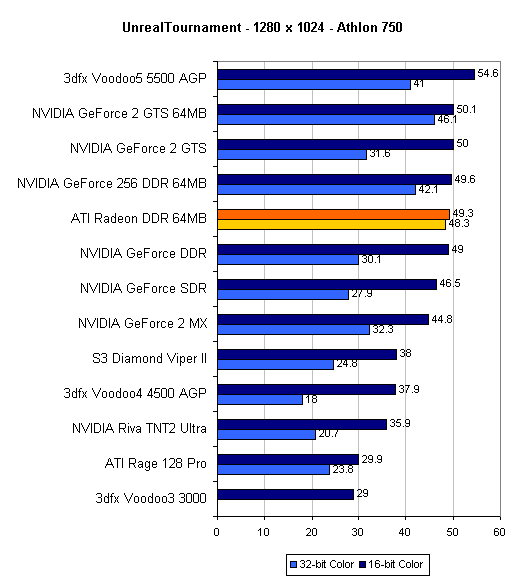
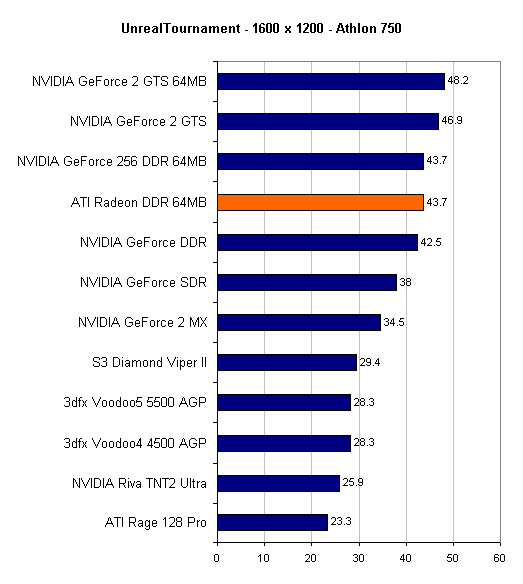
The Radeon flexes it's muscle when in 32-bit color in higher resolutions, but its 16-bit color performance is still low. The Radeon actually beats all cards when at 1280x1024x32. At 1600x1200, the Unreal Engine can not run at 32-bit color, so the Radeon is severely crippled, tying with the GeForce 256 DDR.
Unreal Tournament - Pentium III 550E
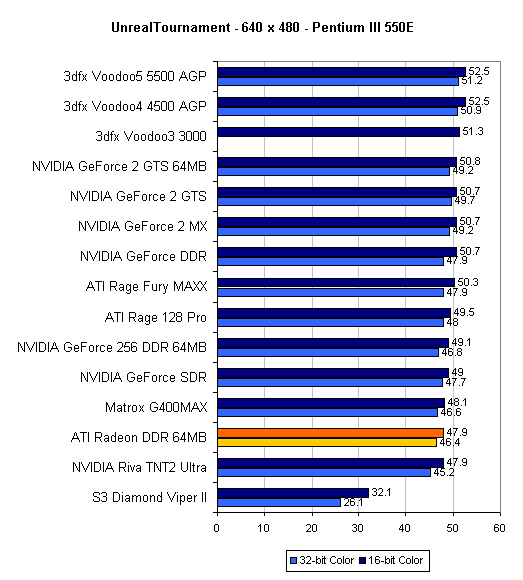

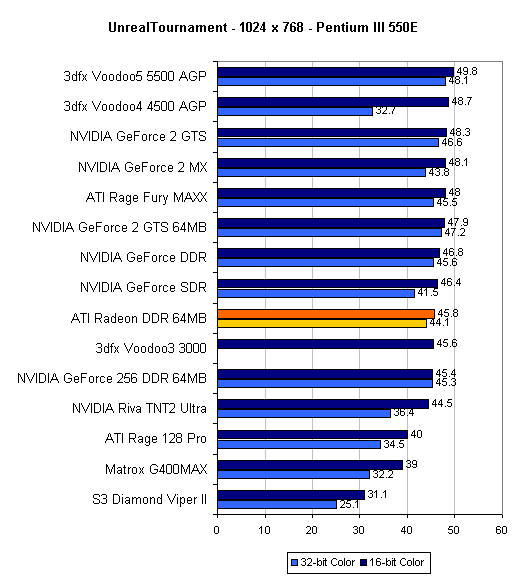
Testing with the "lower end" Pentium III 550E system, we find results very similar to those of the Athlon 750 system. Although the Radeon may appear at the bottom of the 640x480 graph, it is only due to the fact that there is essentially no difference between the cards at this resolution. Here, the Radeon 64MB DDR is essentially tied with all other cards with exception to the Voodoo cards. We see the same results through 1024x768, with the Radeon falling essentially in the middle of the high-end pack.
Unreal Tournament - Pentium III 550E (cont)


At 1280x1024, the Radeon 64MB DDR really begins to catch up. Going almost as fast as the GeForce 2 GTS when in 16-bit color, the Radeon only falls 1 FPS behind the GeForce 2 GTS 64MB when in 32-bit color. At 1600x1200, where UT will only run in 16-bit color, the Radeon 64 MB DDR is only slightly beat by the 32MB GeForce 2 GTS cards but takes quite a wallop from the GeForce 2 GTS 64MB.
Overclocking
While ATI neither recommends nor endorses overclocking (what company does), the possibility of overclocking is found in a third party program: PowerStrip. Used for years, PowerStrip has always provided good support for the overclocker. By implementing support for the Radeon chip in the beta version of PowerStrip, ATI provided an outlet for the true hard-core gamer.
The beta version of PowerStrip that we had enabled for easy overclocking of both the Radeon core as well as its memory clock. Both settings can be adjusted independently, meaning that we were able to push both the core and the memory to the highest amounts that our card would go.
Just how high were we able to get the Radeon to go? Well, as with all .18 micron video card processors, heat was really not an issue when overclocking. Unlike prior .25 micron chips, those based on .18 micron no longer burn when you touch them. As a result of this, chip quality issues are hit long before heat issues.
When overclocking, we were able to get the core of our Radeon 64MB card up to 225 MHz, 40 MHz above the card's shipping speed. Pushing the core any further resulted in not only Quake III Arena crashes but also green text in Windows. The most disappointing thing about raising the core clock was that it resulted in very nominal performance gains, suggesting once again that we had hit a memory bus bandwidth limitation.
As suspected, performance jumped significantly when the 183 MHz DDR memory was pushed higher. Rated at 5.5 ns, the RAM was running at its speced speed, however, as in the past, we were able to push the Hyundai SDRAM chips even further. With PowerStrip pushing up the memory clock speed, we were able to get the DDR SDRAM chips up to 205 MHz DDR for an effective memory clock speed of 410 MHz. At this speed were were finally able to see the true power of the Radeon's core, as performance kept increasing as the memory clock was pushed higher and higher. Unfortunately, at speeds above 205 MHz, snow artifacts began to surface in Quake III Arena runs.
What the tests showed was that once again memory bandwidth is the limit in today's high end video accelerators. Luckily, with the core speed up to 225 MHz and the memory running at 205 MHz DDR, we had an even more powerful card on our hands. Let's take a look and see how it performed.
Overclocked Performance - Quake III Arena Athlon 750

Overclocking the Radeon when at 640x480 provided for essentially no performance increase. This is most likely a result of immature drivers.

Overclocking Radeon at 800x600 almost alleviates that nagging 16-bit color performance. When overclocked, the Radeon was able to perform 2.2 FPS faster than the card at the default clock speed. Also when overclocked, the Radeon was able to flex its 32-bit power earlier than before. The card at 225/205 was able to beat out all other contenders when at 800x600x32, with a frame rate 103.1 FPS. This shows a 1.7% speed increase over the default clock.

At 1024x768 the Radeon's 16-bit color performance still lags drastically behind the GeForce 2 GTS even when overclocked. It is fortunate, however, that overclocking the card does result in a noticeable increase of 4.8 FPS when in 32-bit color, allowing the overclocked Radeon 64MB DDR to beat the competition by 3.2 FPS.
Overclocked Performance - Quake III Arena Athlon 750 (cont)

As suspected, boosting the speed of the Radeon added for a nice performance increase. Still rather slow in 16-bit color, the overclocked Radeon is able to topple the GeForce 2 GTS to an even greater extent when in 32-bit color. The resulting 55.3 FPS when in Quake III Arena demo001 allowed for the overclocked Radeon 64MB DDR to go 11.9% (5.9 FPS) faster than the previous king of the hill: the GeForce 2 GTS 64MB DDR.

1600x1200x32 by far shows the largest performance increase that the Radeon experiences. 16-bit color is lagging, but the overclocked card's 32-bit performance is anything but slow. The card performed 3.7 (10.5%) faster than the GeForce 2 GTS 64MB.
Overclocked Performance - Unreal Tournament Athlon 750
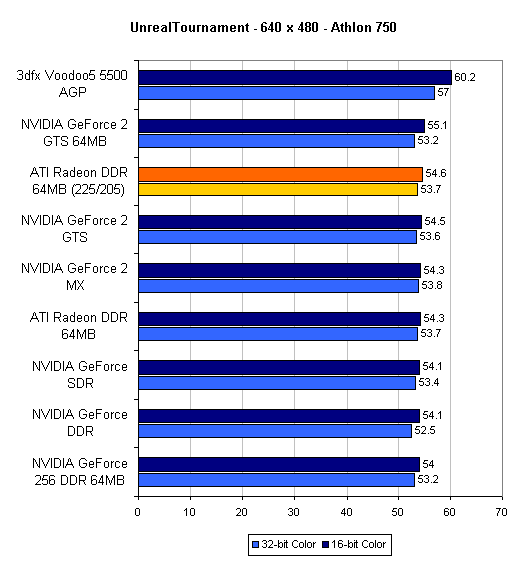
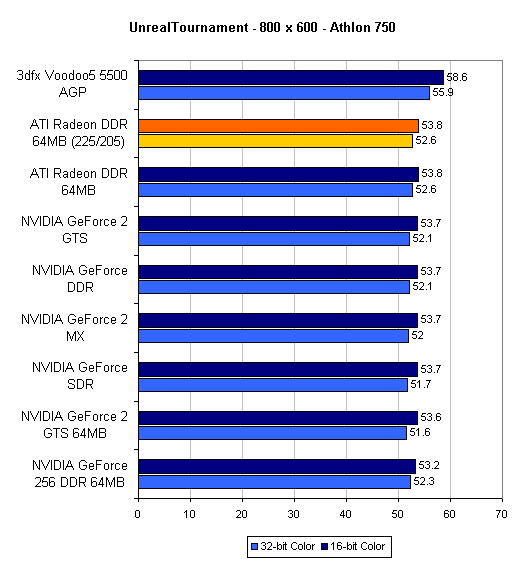
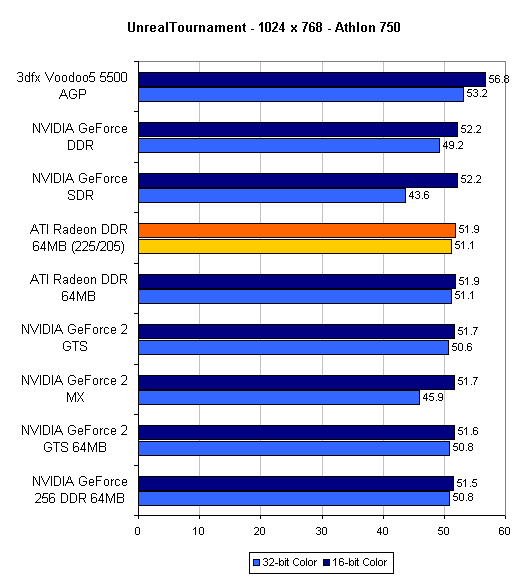
Unreal performance did not increase at all when overclocked. This is most likely a result of the actual game engine rather than the video card itself, as other cards have shown similar results when overclocked.
Overclocked Performance - Unreal Tournament Athlon 750 (cont)
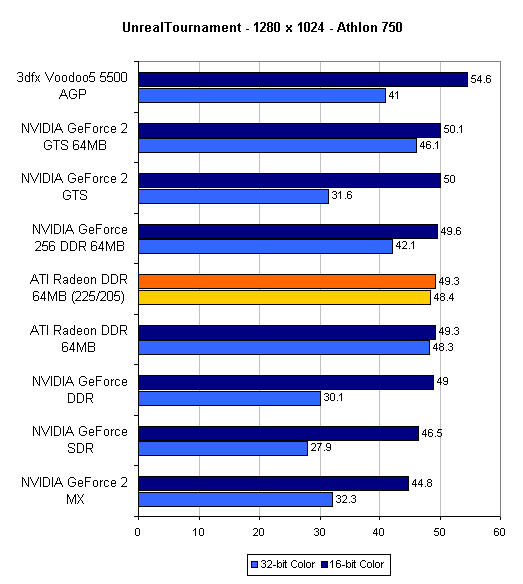
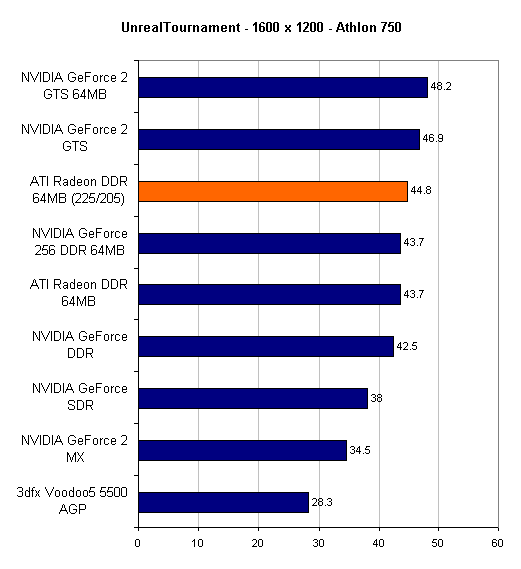
As with other video cards, overclocking the Radeon 64MB DDR in Unreal Tournament made for no speed difference. In fact, the card's performance was only raised by .1 FPS when at 1600x1200x16.
FSAA Quality
Unlike 3dfx's T-Buffer solution for FSAA implementation, ATI took the same route as NVIDIA, using super sampling for FSAA. ATI did not seem very keen on the idea of using FSAA in any situation, an aspect that may explain the poor driver support for this feature. The only FSAA mode available is controlled by a single check box indicating FSAA enabled or disabled. With the check box unchecked, the card runs in standard non-FSAA mode. When checked, the drivers force the game to be rendered using FSAA 4x mode (2x by 2x in NVIDIA's terms). Although this may offer a simpler FSAA solution for those not familiar with the option, the lack of FSAA settings seen in competitor's drivers significantly reduces the number of game-play options.
As mentioned before, ATI does not view FSAA as a viable gaming solution. Citing huge performance drops, ATI argues that improving image quality does not come from blurring the scene but rather running at higher resolutions. Although this can be argued almost endlessly, not including any FSAA driver support would hurt the Radeon's high performance image, as many would see this as a missing feature. By including FSAA 4x, ATI can claim FSAA support on box, even though the number of FSAA choices are drastically less than those of competitors.
How does ATI's 4x only FSAA mode look? We will be taking a more comprehensive look at FSAA quality in the coming weeks, but let's take a quick peak at the Radeon's FSAA quality.
Radeon
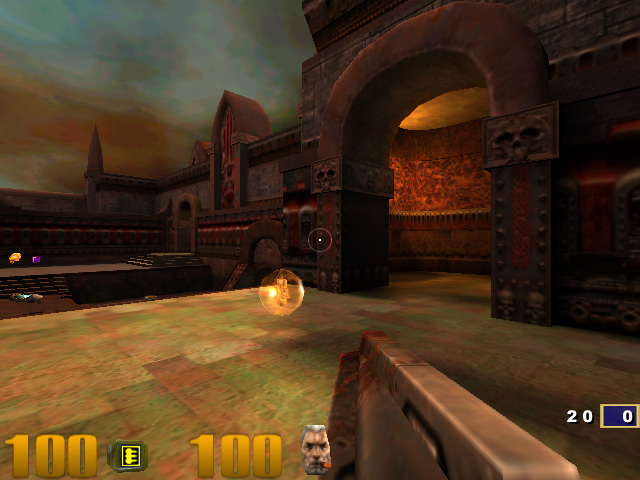 |
|
Radeon, FSAA off
|
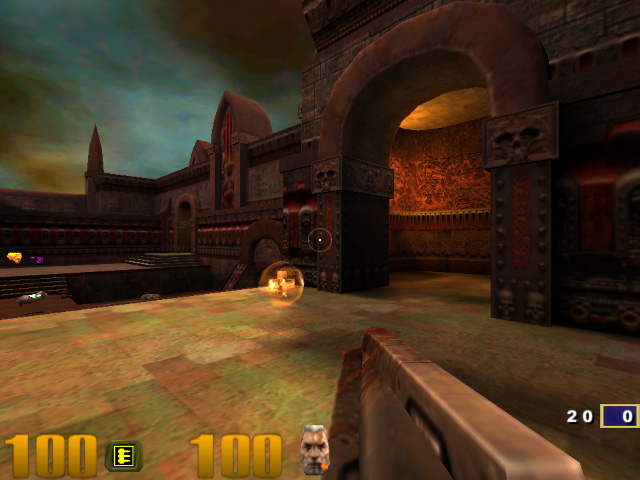 |
|
Radeon, FSAA on (4X super sampled)
|
NVIDIA GeForce 2 GTS
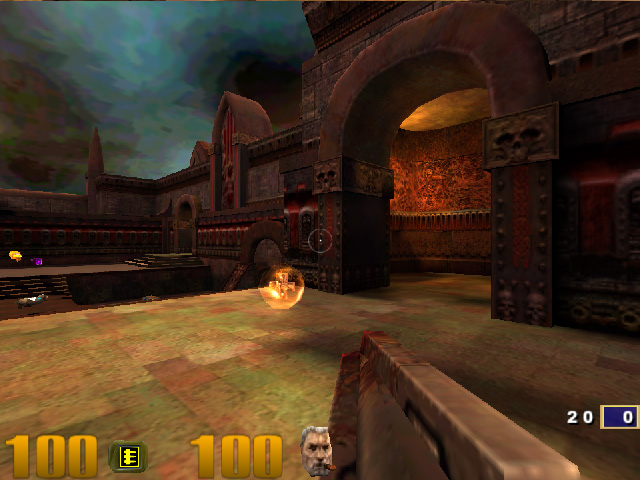 |
|
GeForce 2 GTS FSAA 1.5 screen resolution
|
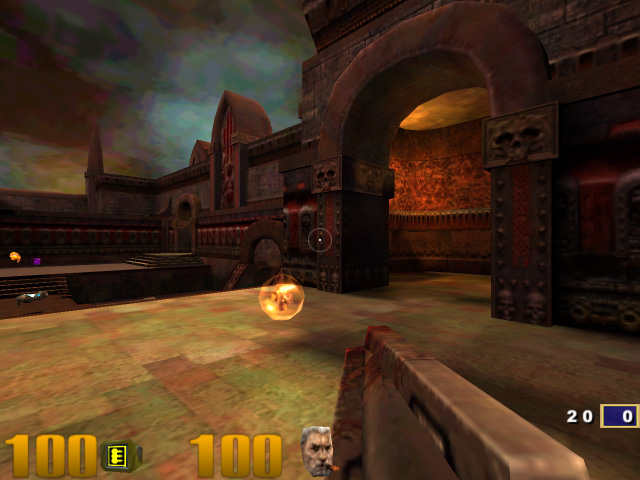 |
|
GeForce 2 GTS 2x screen resolution, with LOD’s
(MIPMaps) at the native game resolution
|
 |
|
2x screen resolution with MIPMaps at the 2x resolution
|
3dfx Voodoo5 5500
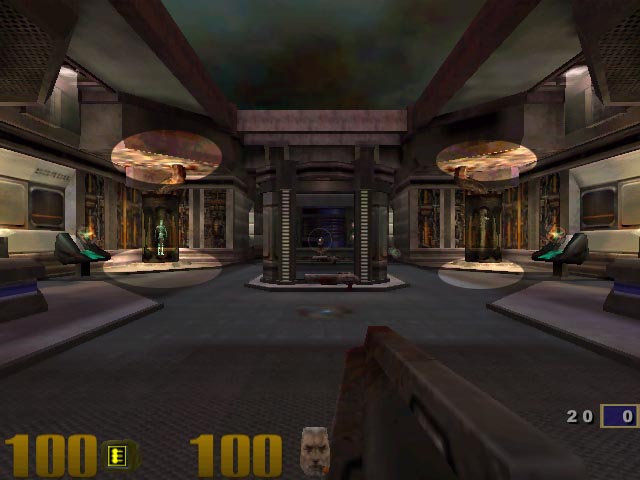 |
|
Voodoo5
5500, FSAA off
|
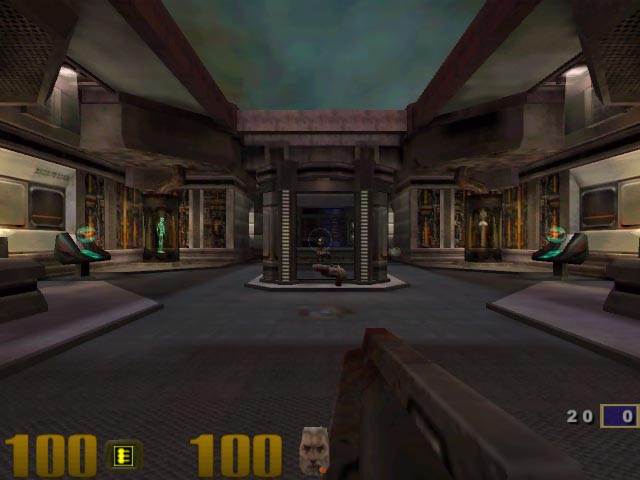 |
|
Voodoo5
5500, FSAA 2 sample
|
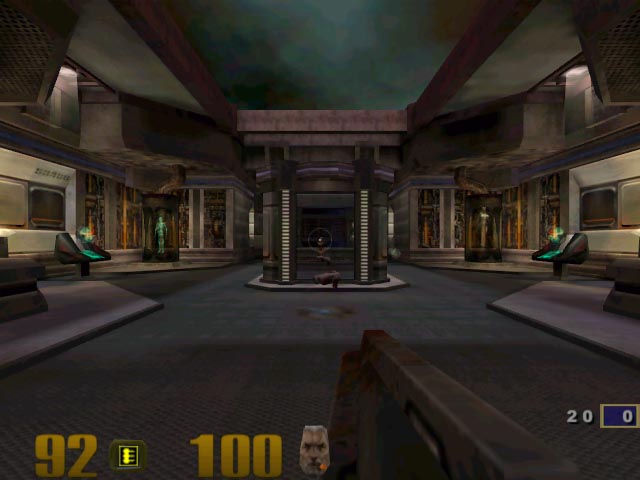 |
|
Voodoo5
5500, FSAA 4 sample
|
As the screen shots show, the Voodoo5 5500 in 4 sample mode dominates the new comer to the game, the Radeon. The Radeon's image quality with FSAA enabled seems to be about equivalent to the GeForce 2 GTS when in 2x2 high quality mode. While the may look similar, let's see if they perform similar
FSAA Performance - OpenGL
As always, FSAA comes at a price. Due to the fact that each pixel must essentially be rendered 4 times before finally making it to the monitor, enabling FSAA on the Radeon causes a huge performance hit.

As the above graph shows, performance is about halved in each resolution with FSAA enabled. This means that really the only playable resolutions are 640x480 and 800x600. Above this level, the Radeon's 4x only FSAA mode becomes too much for the card to handle. Let's see how the card compares to other cards when running in FSAA mode.

As mentioned before, the image quality of the Radeon with FSAA enabled has about the same image quality as NVIDIA's cards in 2x2 HQ mode. Thus, it is most useful to compare it to these scores if the GeForce 2 GTS cards.
As you can see, the Radeon still gets dominated when in 16-bit color, due to its slow performance in 16-bit even with FSAA off. At 16-bit color, the Radeon is easily dominated by the GeForce 2 GTS. The Voodoo5 5500 in 4X mode provides for a much better image, however it does run a bit slower. In 32-bit color, the Radeon looks as good as the GeForce 2 GTS in 2x2 mode high quality, but it goes much faster. This makes gameplay in FSAA in 640x480x32 an option for gamers.

When at 800x600x16, the Radeon performs almost equally with the GeForce 2 GTS in 2x2 HQ mode. It is not until the Radeon 64MB DDR is forced to use FSAA in 32-bit color does it begin to rock. With a much more playable frame rate of 50.7 FPS, the Radeon beats the equally as good looking GeForce 2 GTS in 2x2 high quality mode by over 30 FPS. ATI may not think much of FSAA, but the Radeon sure does.

At 1024x768, running FSAA on any card becomes almost pointless. Since the high resolution is killing speed anyway, the last thing one needs is another thing being rendered. We find that the Radeon essentially ties with the GeForce 2 GTS in 2x2 HQ mode and comes out way on top in 32-bit color. Too bad the card still only gets 29.7 FPS, well too slow for fast gameplay.
Conclusion
It is no question that ATI set out to produce a GeForce 2 GTS killer. At a suggested retail price of $399 for the 64MB version reviewed here and $279 for the 32MB DDR version, the Radeon cards are priced very competitively with NVIDIA's and 3dfx's latest offering. How does the Radeon hold up?
There is no question about it, the Radeon 64MB DDR is one powerful card. Arriving at a shelf near you starting today, ATI has eliminated one major setback of their previous products: the delays. By actually releasing the Radeon before the planned shipping date, ATI proved that they will not go down that easily. As a result of the early shipping date, the Radeon 64MB DDR is also one of the first cards that ATI has released that is able to keep up and occasionally surpass the fastest cards out there.
On top of finally delivering when promised, ATI also included many goodies into the Radeon 64MB DDR that make it very attractive to the home user. Not only does the Radeon ensure card longevity, as it features support for many of the upcoming DirectX 8 features, it also incorporates some extra toys that many will find useful. The video-in and video-out capabilities of the Radeon 64MB DDR are the first to be found on a card with this much gaming power. Also, the incredible DVD playback from the integrated IDCT will be loved by many, especially thanks to the included composite and S-Video out ports.
With all it has going for it, the Radeon most definitely still has some problems. By far the biggest let down of the Radeon 64MB DDR is its poor 16-bit performance. ATI argues that people are really not playing in 16-bit anymore, and this could very well be the case for many out there, however it would be nice to know that if you need it, 16-bit performance is there. Radeon owners will most likely find themselves always running in 32-bit color primarily as a result of the poor 16-bit rendering. This is fortunate due to the fact that the Radeon's 16-bit speed is essentially the same as its 32-bit speed.
The compatibility problems with some VIA chipsets may cause headaches for some users; luckily there are ways to solve the problem. Also, the drivers are still not up to par with the rest of the competition. Finally, more FSAA options would have been nice so that the user could find the best image/performance setting. Too bad that we are limited to FSAA 4x.
Is the Radeon 64MB DDR for you? Well, that depends on what you want to do. If you want a fast, full featured card, it seems that the Radeon is the best thing out there. It offers many of the advanced video features that we have come to expect from ATI while giving us some unexpected performance. The Radeon is also for those out there who are sure that high resolution 32-bit color is the only way to go. In a way it is nice that the Radeon scores top card at these settings, as scenes do look best here. The only downside is that if newer games come along that may be too powerful for the Radeon, one would be stuck playing the game about the same speed regardless of color depth. This is unlike other video cards out there, that show substantial performance increases when switching from 32-bit to 16-bit color.
The production and shipping of the Radeon as well as the move to a 6-month product cycle most certainly shows that ATI is still in the running as a top video card manufacturers. Long gone are the days of poor performance and broken promises. With the release of the Radeon, ATI no longer targets OEMs only, but rather they are winning a spot in the retail consumer's heart. Look like Carmack was right: "ATI may give nvidia a serious run for their money this year."

